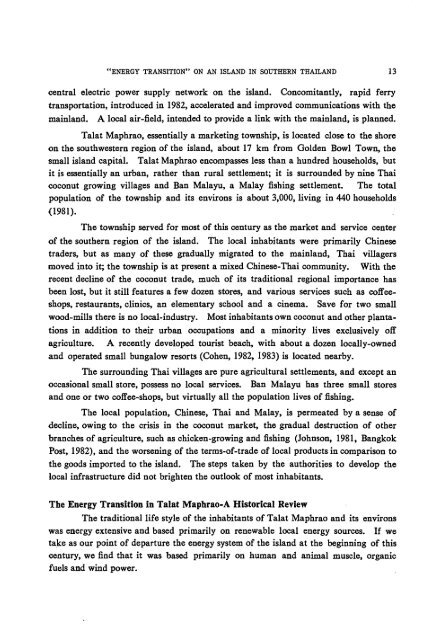The Journal of the Siam Society Vol. LXXI, Part 1-2, 1983 - Khamkoo
The Journal of the Siam Society Vol. LXXI, Part 1-2, 1983 - Khamkoo
The Journal of the Siam Society Vol. LXXI, Part 1-2, 1983 - Khamkoo
You also want an ePaper? Increase the reach of your titles
YUMPU automatically turns print PDFs into web optimized ePapers that Google loves.
"ENERGY TRANSITION" ON AN ISLAND IN SOUTHERN THAILAND 13<br />
central electric power supply network on <strong>the</strong> island. Concomitantly, rapid ferry<br />
transportation, introduced in 1982, accelerated and improved communications with <strong>the</strong><br />
mainland. A local air-field, intended to provide a link with <strong>the</strong> mainland, is planned.<br />
Talat Maphrao, essentially a marketing township, is located close to <strong>the</strong> shore<br />
on <strong>the</strong> southwestern region <strong>of</strong> <strong>the</strong> island, about 17 km from Golden Bowl Town, <strong>the</strong><br />
small island capit~l. Talat Maphrao encompasses less than a hundred households, but<br />
it is essentially an urban, ra<strong>the</strong>r than rural settlement; it is surrounded by nine Thai<br />
coconut growing villages and Ban Malayu, a Malay fishing settlement. <strong>The</strong> total<br />
population <strong>of</strong> <strong>the</strong> township and its environs is about 3,000, living in 440 households<br />
(1981).<br />
<strong>The</strong> township served for most <strong>of</strong> this century as <strong>the</strong> market and service center<br />
<strong>of</strong> <strong>the</strong> sou<strong>the</strong>rn region <strong>of</strong> <strong>the</strong> island. <strong>The</strong> local inhabitants were primarily Chinese<br />
traders, but as many <strong>of</strong> <strong>the</strong>se gradually migrated to <strong>the</strong> mainland, Thai villagers<br />
moved into it; <strong>the</strong> township is at present a mixed Chinese-Thai community. With <strong>the</strong><br />
recent decline <strong>of</strong> <strong>the</strong> coconut trade, much <strong>of</strong> its traditional regional importance has<br />
been lost, but it still features a few dozen stores, and various services such as c<strong>of</strong>feeshops,<br />
restaurants, clinics, an elementary school and a cinema. Save for two small<br />
wood-mills <strong>the</strong>re is no local-industry. Most inhabitants own coconut and o<strong>the</strong>r plantations<br />
in addition to <strong>the</strong>ir urban occupations and a minority lives exclusively <strong>of</strong>f<br />
agriculture. A recently developed tourist beach, with about a dozen locally-owned<br />
and operated small bungalow resorts (Cohen, 1982, <strong>1983</strong>) is located nearby.<br />
<strong>The</strong> surrounding Thai villages are pure agricultural settlements, and except an<br />
occasional small store, possess no local services. Ban Malayu has three small stores<br />
and one or two c<strong>of</strong>fee-shops, but virtually all <strong>the</strong> population lives <strong>of</strong> fishing.<br />
<strong>The</strong> local population, Chinese, Thai and Malay, is permeated by a sense <strong>of</strong><br />
decline, owing to <strong>the</strong> crisis in <strong>the</strong> coconut market, <strong>the</strong> gradual destruction <strong>of</strong> o<strong>the</strong>r<br />
branches <strong>of</strong> agriculture, such as chicken-growing and fishing (Johnson, 1981, Bangkok<br />
Post, 1982), and <strong>the</strong> worsening <strong>of</strong> <strong>the</strong> terms-<strong>of</strong>-trade <strong>of</strong> local products in comparison to<br />
<strong>the</strong> goods imported to <strong>the</strong> island. <strong>The</strong> steps taken by <strong>the</strong> authorities to develop <strong>the</strong><br />
local infrastructure did not brighten <strong>the</strong> outlook <strong>of</strong> most inhabitants.<br />
<strong>The</strong> Energy Transition in Talat Maphrao-A Historical Review<br />
<strong>The</strong> traditional life style <strong>of</strong> <strong>the</strong> inhabitants <strong>of</strong> Talat Maphrao and its environs<br />
was energy extensive and based primarily on renewable local energy sources. If we<br />
take as our point <strong>of</strong> departure <strong>the</strong> energy system <strong>of</strong> <strong>the</strong> island at <strong>the</strong> beginning <strong>of</strong> this<br />
century, we find that it was based primarily on human and animal muscle, organic<br />
fuels and wind power.

















